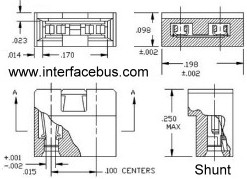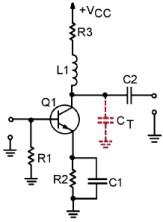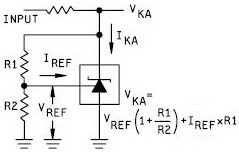Dictionary of Electrical and Electronic Terms
"A"
"B"
"C",
"D",
"E",
"F",
"G",
"H",
"I",
"J",
"K",
"L",
"M",
"N",
"O",
"P",
"Q",
"R",
"S",
"T",
"U",
"V",
"W",
"X",
"Y",
"Z"
"S" to "Sec",
"Sel" to "Series pa", "Series pe" to "Shr",
"Shu" to "Sil", "Sim" to "Skip",
"Sky" to "Spe",
"Spi" to "Sta",
"Ste" to "Stz", "Su", "Sw",
"Sx" to "Sz"
Shunt. A small plastic female Jumper [picture to right]. A shunt is normally a two terminal component on 0.1 inch centers which is fitted over a dual-row headed with the same dimensions. |
 2-Terminal Shunt |
In some cases a Shunt could be a wire, in other cases a shunt may be a resistor. A resistive device placed in parallel with another component. Appreciable current may flow
through it and an appreciable voltage may exist across it. Also see Resistor Shunt [Dictionary of Resistor Terms].
Shunt-Diode Detector. A diode detector in which the diode is in parallel with the input voltage
and the load impedance. Also known as a current detector because it operates with smaller input levels.

Shunt Diode Detector
Shunt-Fed Oscillator. An oscillator that receives its dc power for the transistor or tube through a path both separate from and parallel to the tank circuit. Refer to the example Shunt-Fed Armstrong Oscillator circuit.
Shunt Peaking. A technique used to improve high-frequency response in which a peaking coil is
placed in parallel (shunt) with the output signal path. In the example amplifier to the right the shunt peaking coil [L1] is used to compensate for the parasitic capacitance which is shunting the output signal to ground. As the coil increases in inductance over frequency, it counter acts the capacitance which is decreasing over frequency.
Shunt Resistor. A resistor in parallel with another component or device. In an ammeter, shunt resistors are used to provide multiple ranges.
Shunt Voltage Regulator. A regulator whose regulating device is in parallel with the load
resistance. 3-Terminal Shunt Regulator shown.
Shunt-Wound Motors and Generators. Machines in which the armature and field
windings are connected in parallel (shunt) with each other.
Siamese Cable. A composite cable. A dual function cable consisting of two different cable runs, run side-by-side, in the same molded jacket, which appears as two different cables bonded together and having two different diameters. The most common application for a Siamese Cable is with CCTV cameras; combining both RG59 for video and a pair of 18-gauge cables [18-2], in one jacket, for power. However Siamese style cable is also used to run dual coaxial lines, dual RG59 lines, dual CAT6 pairs, or RG6 coax and CAT5 lines. Some companies may use the term Siamese cable to refer to two different cable types combined with the same jacket with a single diameter, which differers from the meaning of two side-by-side diameter cables bonded together.
Common cable lengths are available in 500 or 1000 foot rolls, but the actual possible cable length depends on the application. |  Siamese Cable |
Sideband. In amplitude modulation (AM), a band of frequencies higher than or lower than the carrier frequency, containing energy as a result of the modulation process.
Siemens. The preferred term for MHO.
Signal. A general term used to describe any ac or dc of interest in a circuit; for example, input signal. Detectable transmitted energy that can be used to carry information. A variation of the physical quantity used to convey data.
Signal Compression. In analog (usually audio) systems, reduction of the dynamic range of a signal by controlling it as a function of the inverse relationship of its instantaneous value relative to a specified reference level.
Signal Distortion. Any unwanted change to the signal.
Signal Droop: In an otherwise essentially flat-topped rectangular pulse, distortion characterized by a decline of the pulse top. Refer to Pulse Droop, part of the collection of Pulse terms.
Signal Ground. The return path of a signal, which may be separate from a circuit ground or equipment ground.
Signal Leakage. See Cable Leakage.
Signal-Return Circuit. A current-carrying return path from a load back to the signal source, i.e., the low side of the closed loop energy transfer circuit between a source-load pair.
Signal Sampling. The process of obtaining a sequence of instantaneous values of a particular signal characteristic, usually at regular time intervals.
Signal-to-Noise Ratio. The ratio of the electrical output signal to the electrical noise generated. The ratio of the amplitude of the desired signal to the amplitude of noise signals at a given point in time. SNR is expressed as 20 times the logarithm of the amplitude ratio, or 10 times the logarithm of the power ratio.
Significant Digit. In a representation of a number, a digit that is needed for a given purpose; in particular,
a digit that must be kept to preserve a given accuracy or a given precision.
Significant Sidebands. Those side-bands with significantly large amplitude.
Silent Data Corruption. [SDC] Data corruption that occurs in a computing system without any error being logged, no CRC error, or Parity error or any other indication that an error occurred. SDC may occur from any cause.
Silicon. A metallic element which, in its pure state, is used as a semiconductor. A chemical element, atomic number 14, semi-metallic in nature, dark gray, an excellent semiconductor material. A common constituent of sand and quartz (as the oxide). Crystallizes in face-centered cubic lattice like a diamond.
Silicon-Controlled Rectifier. [SCR] A semiconductor device that functions as an
electrically controlled switch. Also known as a Thyristor. A PNPN semiconductor device. A 3-terminal semiconductor device consisting of a Gate, Anode and, Cathode. SCR Vendors.
Silicon-Controlled Switch. [SCS] A four layer, four terminal pnpn Thyristor. Each p-type and n-type layer has a terminal connected to it. A much older term used was tetrode thyristor, to indicate the device had four terminals. | SCS |
Silicon Unilateral Switch. [SUS] A component similar to a silicon controlled switch, but having a zener gate added to the Anode gate so the device is triggered at a specific voltage. [SUS Vendors]
Silver Mica Capacitor. A capacitor that uses mica as a dielectric, but the mica has a layer of silver layered on the mica, instead of some other metal. Review more Terms used with Capacitors.











